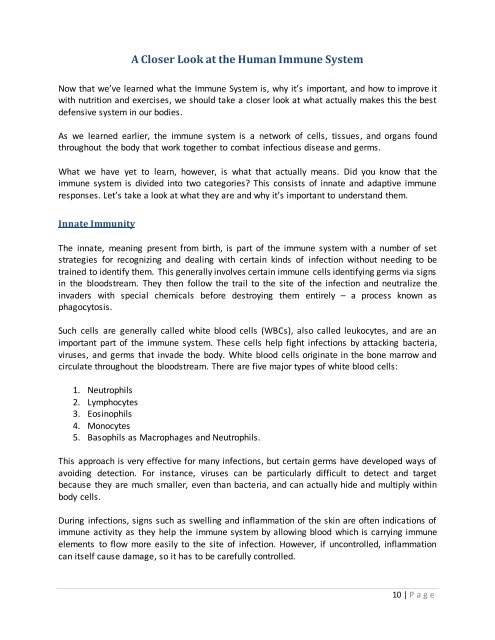The Gift of Knowledge
Empower yourself and learn about how your immune system works and how to take care of it naturally.
Empower yourself and learn about how your immune system works and how to take care of it naturally.
- No tags were found...
You also want an ePaper? Increase the reach of your titles
YUMPU automatically turns print PDFs into web optimized ePapers that Google loves.
A Closer Look at the Human Immune System<br />
Now that we’ve learned what the Immune System is, why it’s important, and how to improve it<br />
with nutrition and exercises, we should take a closer look at what actually makes this the best<br />
defensive system in our bodies.<br />
As we learned earlier, the immune system is a network <strong>of</strong> cells, tissues, and organs found<br />
throughout the body that work together to combat infectious disease and germs.<br />
What we have yet to learn, however, is what that actually means. Did you know that the<br />
immune system is divided into two categories? This consists <strong>of</strong> innate and adaptive immune<br />
responses. Let’s take a look at what they are and why it’s important to understand them.<br />
Innate Immunity<br />
<strong>The</strong> innate, meaning present from birth, is part <strong>of</strong> the immune system with a number <strong>of</strong> set<br />
strategies for recognizing and dealing with certain kinds <strong>of</strong> infection without needing to be<br />
trained to identify them. This generally involves certain immune cells identifying germs via signs<br />
in the bloodstream. <strong>The</strong>y then follow the trail to the site <strong>of</strong> the infection and neutralize the<br />
invaders with special chemicals before destroying them entirely – a process known as<br />
phagocytosis.<br />
Such cells are generally called white blood cells (WBCs), also called leukocytes, and are an<br />
important part <strong>of</strong> the immune system. <strong>The</strong>se cells help fight infections by attacking bacteria,<br />
viruses, and germs that invade the body. White blood cells originate in the bone marrow and<br />
circulate throughout the bloodstream. <strong>The</strong>re are five major types <strong>of</strong> white blood cells:<br />
1. Neutrophils<br />
2. Lymphocytes<br />
3. Eosinophils<br />
4. Monocytes<br />
5. Basophils as Macrophages and Neutrophils.<br />
This approach is very effective for many infections, but certain germs have developed ways <strong>of</strong><br />
avoiding detection. For instance, viruses can be particularly difficult to detect and target<br />
because they are much smaller, even than bacteria, and can actually hide and multiply within<br />
body cells.<br />
During infections, signs such as swelling and inflammation <strong>of</strong> the skin are <strong>of</strong>ten indications <strong>of</strong><br />
immune activity as they help the immune system by allowing blood which is carrying immune<br />
elements to flow more easily to the site <strong>of</strong> infection. However, if uncontrolled, inflammation<br />
can itself cause damage, so it has to be carefully controlled.<br />
10 | P a g e
















